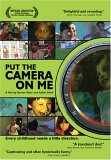| Reviews & Columns |
|
Reviews DVD TV on DVD Blu-ray 4K UHD International DVDs In Theaters Reviews by Studio Video Games Features Collector Series DVDs Easter Egg Database Interviews DVD Talk Radio Feature Articles Columns Anime Talk DVD Savant Horror DVDs The M.O.D. Squad Art House HD Talk Silent DVD
|
DVD Talk Forum |
|
|
| Resources |
|
DVD Price Search Customer Service #'s RCE Info Links |
|
Columns
|
|
|
Put the Camera on Me
The film's focus, sort of, is Darren Stein, Put the Camera on Me's co-director (with Adam Shell), who from roughly the ages of 10 to 15 wrote and directed a series of home movies, using his flamboyant charisma to coax friends into doing almost anything on camera. The films, seen in long excerpts, range from the usual sorts of things amateur filmmakers their age often made - zombie thrillers and lip-synched music videos - to more bizarre and revealing works, from a gleefully dark depiction of a concentration camp execution (most of the neighborhood kids are Jewish) to Gay as a Whistle, a comic-fantasy where everyone on earth is zapped into a state of blissful homosexuality.
It's this latter obsession with all things gay - performing show tunes, dressing in drag, and generally mincing about - that rescues Put the Camera on Me from what might have been an interminable parade of home movie junk. Even watching the earliest clips, when Darren was a pre-teen of perhaps eight or nine, it's immediately clear the dye of his sexuality has already been cast. His work includes a Sondheim-esque musical, and he has a dark sense of humor comparable and perhaps inspired by the films of John Waters and Richard O'Brien (The Rocky Horror Picture Show), and orders everyone about his "sets" (often nothing more than someone's kitchen) like a miniature Kenneth Williams.
At the same time, it's fascinating to watch his interaction with the neighborhood's straight kids and future gay men, including Allen, a young African-American Darren has dress up in his mother's clothes and, by proxy, act out his own burgeoning sexuality. In this sense the film accidentally accomplishes what Michael Apted's Up series tries to do on purpose, show how environment and inter-personal relationships in our childhood and teen years can impact the rest of our lives.
Unfortunately, while Put the Camera on Me spends a lot of time with Darren, it also meanders all over the place, from one girl's crush on another childhood friend, to their parents' bemused reactions to the films and their sometimes morbid obsessions. In the end the general impression is that Put the Camera on Me was made with a hindsight-driven nostalgia for the friends and relatives of those involved, rather than as an entertainment or social commentary geared for a more general audience. It's hard to keep track of who's who at times, and the non-linear chronology, with the home movies moving back and forth in time, adds to the confusion.
Video & Audio
The full frame presentation is problematic. The amateur films were shot in the earliest days of home video technology, so their quality is often poor, with a soft image and greenish color. As a child-filmmaker, Darren is chiefly interested in recording performances (and sex and gore) on-camera, rather than presenting anything like a visual style, making everything play worse than it needs to be. (Interesting, those making amateur movies in 8mm/Super-8 were often just the opposite, obsessed with visual style and disinterested in performance.) Curiously, the newly-shot interviews aren't that much better. One hand-held interview is so shakily shot as to suggest an episode of NYPD Blue. The sound in the home movies is often hard to make out, while the audio in the new interviews and music is cranked up at a much higher level; viewers will want to keep the volume control close at hand. For the record, some (but not all) T-shirt logos and the like in the home movies have been electronically blurred, some music rescored, and some sound effects replaced. There are no subtitle options.
Extra Features
Put the Camera on Me features the kind of supplements fans of the film will want to dig into, while others will want to avoid them like the plague. Nine Original Movies are featured, while a Film Festival Featurette follows directors Adam Shell and Darren Stein as they exhibit their work at the San Francisco Gay & Lesbian Film Festival, the Cinevegas Film Festival and elsewhere. It runs just shy of 13 minutes.
Parting Thoughts
Some will find Put the Camera on Me campy and hilarious; others will be intrigued by parts of it but ultimately turned off by its lack of focus and self-styled nostalgia.
Stuart Galbraith IV is a Kyoto-based film historian whose work includes The Emperor and the Wolf - The Lives and Films of Akira Kurosawa and Toshiro Mifune and Taschen's forthcoming Cinema Nippon. Visit Stuart's Cine Blogarama here.
|
| Popular Reviews |
| Sponsored Links |
|
|
| Sponsored Links |
|
|
| Release List | Reviews | Shop | Newsletter | Forum | DVD Giveaways | Blu-Ray | Advertise |
|
Copyright 2024 DVDTalk.com All Rights Reserved. Legal Info, Privacy Policy, Terms of Use,
Manage Preferences,
Your Privacy Choices | |||||||













